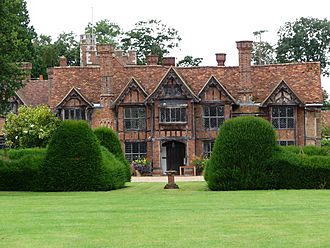Dorney Court facts for kids
Quick facts for kids Dorney Court |
|
|---|---|

Dorney Court, front facade
|
|
| General information | |
| Type | Stately home |
| Town or city | Dorney, Buckinghamshire |
| Country | England |
| Coordinates | 51°30′09″N 0°40′33″W / 51.5024°N 0.6759°W |
Dorney Court is a very old and important house, built around 1440. It is a manor house from the early Tudor period. You can find it in the village of Dorney, in Buckinghamshire, England. The Palmer family has owned and lived in Dorney Court for many centuries.
A Look at Dorney Court's Past
How Dorney Court Began
The land where Dorney Court stands was first written about in the Domesday Book of 1086. This was a huge survey ordered by William the Conqueror to record who owned what in England. Before the Normans arrived, a man named Aldred owned the land.
In 1086, the land belonged to Miles Crispin, and a person named Ralf was living there. Over many years, Dorney Court was owned by several different families. These included the Caves, Parkers, and Hills.
The Palmer Family Takes Over
In 1542, James Hill sold Dorney Court to Sir William Garrard. Sir William later became the Lord Mayor of London, a very important job. The Palmer family, who still own Dorney Court today, are descendants of Sir William Garrard.
The Palmer Family's Story
Sir William Garrard and His Family
Sir William Garrard, who bought Dorney Court in 1542, was the Lord Mayor of London in 1555. He passed away in 1571. His oldest son, also named Sir William Garrard, inherited the property.
Sir William Garrard the younger died in 1607. He left Dorney Court to his wife, Elizabeth. After her death, it was meant to go to his son, Thomas.
How the Palmers Got Dorney Court
Sir William Garrard's daughter was Martha. She married James Palmer, who later became Sir James Palmer in 1629. Dorney Court became the property of Sir James Palmer in 1624. This happened after some disagreements within the Garrard family about who should own the house.
Sir James Palmer: A Man of Many Talents
Sir James Palmer (1585–1658) was the first Palmer to own Dorney Court. He was a younger son from another important Palmer family in Kent. Sir James was a close friend and adviser to King James I and King Charles I.
He was also an artist and painted miniature portraits. Sir James helped the King with his art collection and managed the Royal Tapestry Works. Some of his paintings are still in famous art collections today, like the Victoria & Albert Museum.
Dorney Court Through Generations
Since Sir James Palmer, Dorney Court has been passed down from father to son in the Palmer family. It has stayed in the family right up to the present day.
One of Sir James's younger sons became the Earl of Castlemaine. However, his older son, Sir Philip Palmer, inherited Dorney Court. The house has continued to be a family home for the Palmers for hundreds of years.
Today, Dorney Court is still the home of the Palmer family. However, they also open it up for visitors to explore and enjoy its history.
The House Itself
What Dorney Court Looks Like
When you first see Dorney Court, it looks like a house from the Middle Ages. But some parts of the outside were actually rebuilt in the Victorian era, in the late 1800s. The original bricks were put back on the front of the house to make it look old again.
Inside Dorney Court
The inside of Dorney Court hasn't changed much since the 1500s. The oldest part is the paneled parlor, which has beautiful old furniture.
The great hall is a large room with many family portraits. It has special wooden panels that came from Faversham Abbey in Kent. Long ago, this hall was used for important meetings of the local community. Even today, the annual Commoners' meeting is still held there.


